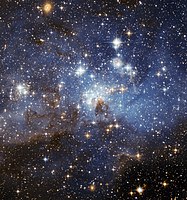
Photo from wikipedia
We present a new set of high-resolution hydrodynamic cosmological zoom-in simulations that apply the Feedback In Realistic Environments physics to both Local Group (LG)-like and isolated Milky Way (MW)-like volumes… Click to show full abstract
We present a new set of high-resolution hydrodynamic cosmological zoom-in simulations that apply the Feedback In Realistic Environments physics to both Local Group (LG)-like and isolated Milky Way (MW)-like volumes (10 host systems in total with a baryonic particle mass ${\simeq } 3500\!-\!7000\,{\rm M}_\odot$). We study the stellar mass functions, circular velocity or mass profiles, and velocity dispersions of the dwarf galaxy populations. The simulations reproduce the stellar mass function and central densities of MW satellite dwarfs for $M_\ast \ge 10^{5.5}\,{\rm M}_\odot$ and predict the existence of ∼3 unidentified galaxies with $M_\ast \sim 10^5\,{\rm M}_\odot$ within 300 kpc of the MW. Overall, we find no evidence for the classical missing satellites or too-big-to-fail (TBTF) problems for satellite galaxies in our sample. Among the satellites, TBTF is resolved primarily by subhalo disruption and overall mass-loss; central density profiles of subhaloes are of secondary importance. For non-satellite galaxies, our LG-like simulations predict as many as ∼10 as-of-yet unseen galaxies at distances $0.3\!-\!1\, \mathrm{Mpc}$ from both hosts, with $M_\ast \simeq 10^{5-6}\,{\rm M}_\odot$ (in haloes with Vmax ∼ 20 km s−1), albeit with large halo-to-halo variance. None of our simulations produces a compact, baryon-dominated, high-density dwarf elliptical-type galaxy (with Vcirc ≳ 35 km s−1 at $r\lt 1\,$ kpc), of which six may appear in the LG (but none in the MW). It may therefore remain a challenge to reproduce the full diversity of the dwarf population, including both the highest and lowest density systems.
Journal Title: Monthly Notices of the Royal Astronomical Society
Year Published: 2019
Link to full text (if available)
Share on Social Media: Sign Up to like & get
recommendations!